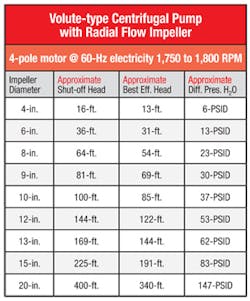(a.k.a. “Pump Guy”)
I really enjoy being the Pump Guy and teaching pump courses with Flow Control. Each class is unique — 20 or 40 people from totally different industries and backgrounds come together in the same room to share and learn. I tell them what I know about pumps, and the students talk about their work.
One of my favorite questions to ask the attendees that come to the Pump Guy Seminar is, “Tell the class something about your work, or the product your company makes that would shock or surprise us as outsiders to your industry?” One of the most memorable responses I got to that question was on my last trip to Michigan.
The class had engineers and mechanics from a cement plant, a municipal water treatment plant, a soap manufacturer, a dry dock, a sausage factory, a wastewater treatment plant, an oil refinery, a slaughter house, a nuclear power plant, a beer brewery, and a major automobile manufacturer.
Just before lunch on the third day of the seminar, I asked a young engineer from the auto manufacturer to surprise us with an interesting tidbit about making cars. The engineer said, “Well, there is a place not too far from here where the company studies other cars. We have people who discreetly visit the showrooms and dealerships of our competitors. We pay list price to avoid a paper trail. We bring the new cars to this building and totally disassemble them to see how they are designed — this is how we know that our designs are the best. Also, if we see a design, device or accessory we like, we will incorporate the competitor’s concept into our future models.”
As we ate lunch that day, the engineer quietly offered to show me the secret disassembly plant. He made me promise not to bring my camera. I asked, “Won’t you get into trouble by showing me this secret place?” He said, “It’s okay. Besides, I’m not going to make a career with this company. I’ll move on in a few more years.” So, I agreed not to bring my camera.
I saw the place. He was right. There they were ¬— assorted models of new American cars, German cars, Japanese, Swedish, Korean, Italian, Chinese, British, and even French, Czech, and Russian cars all laid out in individual pieces. Technicians with white lab coats inspected door hinges, cam shafts, pistons, exhaust pipe flanges, seat cushions, headliner padding, ash trays, glove box door-locks, wheel rims, brake cables, and spring-loaded cup holders. I should have brought my camera.
Later, I learned the auto industry isn’t alone. All manufacturers study their competitors’ products, including the pump industry, the mechanical seal industry, and the bearing industry.
All universities teach the same courses in the engineering curriculum. All engineering courses use the same text books with the same information. The graduate engineers all use the same computer programs to design their perfect impellers and volutes. And if a pump manufacturer presents a new product with an original design or concept, all competitors will have studied it and dissected it within a few days in their secret laboratories. And people, that’s the way it is!
There really are very few secrets in the pump industry. And most pumps (centrifugal pumps and PD pumps) of similar design will perform about the same, with the same liquid in a similar application.
Centrifugal pumps fall into three categories. The largest category is the “volute” centrifugal pump. “Diffuser” and “concentric” centrifugal pumps are the other categories. There are also three main categories of impeller design. These designs are radial-flow, mixed-flow, and axial-flow impellers. The radial-flow impeller is the largest category of impeller design.
The shutoff head (second column) is the beginning of all pump curves. It represents maximum head at zero flow. Using Imperial units at 1,800 RPM, the impeller diameter in inches, multiplied by itself or squared, is the approximate ‘Shut-off Head’ of the pump in feet.
Let’s say the pump is directly coupled to a four-pole alternating current electric motor. A 6-inch impeller rotating at 1,800 RPM will develop approximately 36 ft of shutoff head (6 x 6 = 36). A 10-inch impeller spinning at 1,800 RPM will develop approximately 100 ft of shutoff head (10² = 100). You can look at any pump manufacturer’s performance curve and confirm this. Notice: I say approximately, not exactly.
The pump is not efficient at shutoff head. The “best efficiency head” (third column) is approximately 85 percent of the shutoff head. What does “efficiency” mean?
Efficiency in a centrifugal pump is the best combination of head and flow at the least energy consumption. On most centrifugal pumps (volute pumps with a radial flow impeller), best efficiency head falls somewhere between 80 percent and 90 percent of the shutoff head. Therefore, 85 percent is a valid approximate target as best efficiency head. Notice: I am not saying that most pumps are 85 percent efficient. I am saying that the best efficiency head of most pumps is normally about 85 percent of the shutoff head.
As the differential pressure across the pump rises, the pump is operating to the left of best efficiency. The pump is operating to the right of best efficiency if the differential pressure reduces across the pump. Unscheduled maintenance and mysterious failures rise as the pump moves away from best efficiency.
You’d think the reliability and process engineers know this, but my experience indicates they don’t. I see too many pumps every day without adequate gauges and instrumentation, and no one can find their pump curves.
When the pump is properly mated into the system, and operated properly, the pump will run for many years without problems or mysterious failures. This is similar to operating a car.
The driver must know how to hold a car onto the pavement, avoid traffic upsets, and accidents even as the roadway changes and traffic conditions change. The driver uses the steering wheel, the brake pedal, the gas pedal, turn signals, lights, transmission, and the dash instrumentation panel to operate and control the car.
Likewise, the tools and devices to control process pumps are pressure gauges, flowmeters, control valves, other valves and restrictors, level indicators, temperature indicators, and other instrumentation where necessary.
Locate and study the performance curves of your pumps. You will see that most of your centrifugal pumps (those volute pumps with radial-flow impellers), rotating at 1,750 to 1,800 RPM, will exhibit approximately the same shutoff head. You’ll see the best efficiency head is approximately 85 percent of the shutoff head. Then, learn to operate your pumps at the head and flow of best efficiency.
Storing pump curves in a file, in a drawer, in a locked cabinet leads to mysterious pump failure. You may never hear these words from your pump manufacturers because they really want to sell spare parts. Your maintenance device suppliers (ultrasound, vibration monitors, oil analysis, CMMS programs, etc.) will never help you with your curves because they want you to buy their $50,000 gadgets. They are feeding their families. You must feed your family and secure your position in this tough economy. Your pumps are talking to you. Everyone contributes to reliability.
Larry Bachus, founder of pump services firm Bachus Company Inc., is a regular contributor to Flow Control magazine. He is a pump consultant, lecturer, and inventor based in Nashville, Tenn. Mr. Bachus is a retired member of ASME and lectures in both English and Spanish. He can be reached at [email protected].





